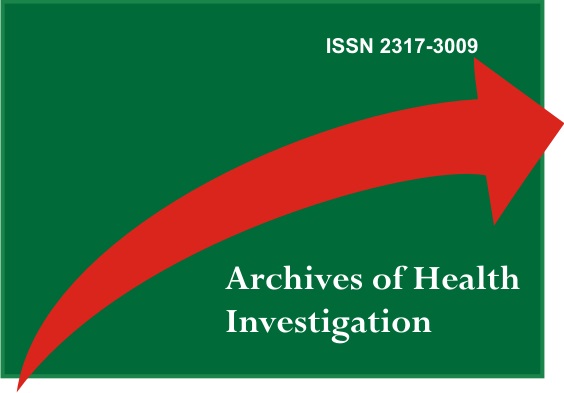Surgical removal of supernumerary tooth included in the mandible region: clinical case report
DOI:
https://doi.org/10.21270/archi.v10i9.5344Keywords:
Tooth, Supernumerary, Cone-Beam Computed Tomography, Surgery, OralAbstract
Introduction. Supernumerary teeth are defined as teeth or any odontogenic structure that are in excess in a certain region of the dental arch. Depending on the anatomical location, supernumerary teeth can cause flaws in the eruption, diastema, root resorption, displacement of adjacent teeth, laceration and the formation of odontogenic lesions. In these cases, the treatment of choice is extraction. Objective. To report a case of extraction of supernumerary tooth even asymptomatic in the posterior region of the mandible. Case report. A 28-year-old male patient was referred by an orthodontist to perform supernumerary tooth extraction in the region of teeth 33 to 35, identified by means of panoramic radiography. Cone beam computed tomography (CBCT) revealed distal inclination and transverse position of the supernumerary tooth, whose crown was located between teeth 34 and 35, with a root close to the root apex of tooth 33 and proximity to the mental foramen and the tooth root 34. In view of the need for orthodontic treatment, tooth extraction was performed. The patient returned after eight days to remove the sutures, without reporting any complaints. After 60 days after surgery, the patient did not report any symptoms in the region where the supernumerary tooth had been extracted. Conclusion. Supernumerary tooth is one of the most common developmental anomalies in humans. The importance of imaging tests for the identification and precise location of this type of anomaly is emphasized, being essential in the case now reported, in which these tests were essential for the diagnosis and correct surgical planning.
Downloads
References
Gurler G, Delilbasi C, Delilbasi E. Investigation of impacted supernumerary teeth: a cone beam computed tomograph (cbct) study. J Istanb Univ Fac Dent. 2017;51(3):18-24.
Lu X, Yu F, Liu J, Cai W, Zhao Y, Zhao S, et al. The epidemiology of supernumerary teeth and the associated molecular mechanism. Organogenesis. 2017;13(3):71-82.
Manchada N, Anthonappa R, King N. Supernumerary teeth formation following subluxation of primary incisors. Dental Traumatol. 2019;35:212-15.
Costa SM, de Jesus AO, Silveira RL, Amaral MBF. Supernumerary nasal tooth removed with a modified maxillary vestibular approach: case report and literature review. Oral Maxillofac Surg. 2019;23(2):247-52.
Cammarata-Scalisi F, Avendaño A, Callea M. Main genetic entities associated with supernumerary teeth. Arch Argent Pediatr. 2018;116(6):437-44.
Kiso H, Takahashi K, Mishima S, Murashima-Suginami A, Kakeno A, Yamazaki T, et al. Third dentition is the main cause of premolar supernumerary tooth formation. J Dent Res. 2019;98(9):968-74.
Park SY, Jang HJ, Hwang DS, Kim YD, Shin SH, Kim UK, et al. Complications associated with specific characteristics of supernumerary teeth. Oral Surg Oral Med Oral Pathol Oral Radiol. 2020;130(2):150-55.
Arikan V, Cumaogullari O, Ozgul BM, Oz FT. Investigation of SOSTDC1 gene in non-syndromic patients with supernumerary teeth. Med Oral Patol Oral Cir Bucal. 2018;23(5):e531-39.
Belmehdi A, Bahbah S, El Harti K, El Wady W. Non syndromic supernumerary teeth: management of two clinical cases. Pan Afr Med J. 2018;29:163.
Zhao L, Liu S, Zhang R, Yang R, Zhang K, Xie X. Analysis of the distribution of supernumerary teeth and the characteristics of mesiodens in Bengbu, China: a retrospective study. Oral Radiol. 2021;37(2):218-23.
Ma D, Wang X, Guo J, Zhang J, Cai T. Identification of a novel mutation of RUNX2 in a family with supernumerary teeth and craniofacial dysplasia by whole-exome sequencing. A case report and literature review. Medicine (Baltimore). 2018;97(32):e11328.
Haghanifar S, Moudi E, Abesi F, Kheirkhah F, Arbabzadegan N, Bijani A. Radiographic evaluation of dental anomaly prevalence in a selected Iranian population. J Dent (Shiraz). 2019;20(2):90-4.
Scully A, Zhang H, Kim-Berman H, Benavides E, Hardy NC, Hu JC. Management of two cases of supernumerary teeth. Pediatr Dent. 2020; 42(1):58-61.
Mahto RK, Dixit S, Kafle D, Agarwal A, Bornstein M, Dulal S. Nonsyndromic bilateral posterior maxillary supernumerary teeth: a report of two cases and review. Case Rep Dent. 2018;2018:5014179.


